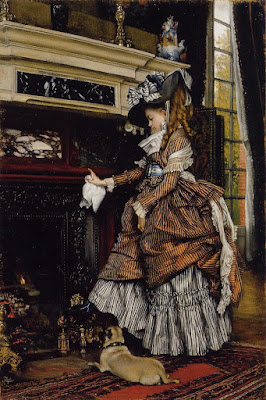Isabella reporting,
As I mentioned in my recent post about this 17thc.
knitted jacket, I'm a knitter myself, and I'm always on the hunt for examples of historical knitted pieces in museums and collections. They aren't easy to find: the wool that was usually used for utilitarian knitting often fell prey to moths, and the pieces that weren't eaten were often worn until they disintegrated. A silk wedding gown, worn once and preserved, is going to have a much higher survival rate than a pair of knitted stockings or mittens that were worn daily.
That's why I was so excited to spot these knitted mitts in the textile and costume study drawers of
Colonial Williamsburg. Knitted for a woman or girl (the wearer could well have been the knitter), the mitts are made of peach-colored silk with a diamond pattern of metallic thread, now tarnished to grey-green. The point that covered the back of the hand is reinforced with pasteboard, and lined with brocaded silk.
The mitts entered the collection with a bit of family history attached, too:
"According to the family in which it descended, this pair of mitts was worn by Anne Butler Brayne, wife of Virginia's Lt. Governor Alexander Spotswood. Anne Butler Brayne was born in 1698 and married Spotswood in England in 1724. The couple later settled in Virginia."
But the mitts themselves have more of a story to tell. They're so well-worn that they must have been favorites of the owner, and possibly successive owners, too. Despite being made of expensive silk and metallic thread, they clearly weren't reserved for special occasions - at least not after some point of their existence.
Because the sleeves of most mid-18thc. European women's dresses ended right below the elbows, mitts (both knitted like these, as well as ones that were cut and sewn of woven cloth) were worn to protect the forearms from the cold and sun. Given their date, these mitts were likely once longer, too, reaching up over the forearms; here's a similar
example. At some point, this pair of mitts was cut off around the wrists, which is why the raw hems curl back on themselves.
That's noted in the Colonial Williamsburg catalogue. But as a knitter (not a scholar - what follows in my own humble opinion), I suspect there were more alterations as well. The pointed tips,
lower right, appear to be a later addition. The yarn is different, and the older stitches along the edge were haphazardly picked up to knit the pointed tip. Every knitter's stitches are individual, and whoever knitted the new tips wasn't as accomplished as the original knitter. Her stitches are irregular and a little looser, and the neat twist of the older stitches is missing. (This could be because the tips were knitted back and forth - knit one row, purl one row - rather than in the round - knit every stitch - the way the older parts of the mitts were done.) It also appears that there was an edging of the silver thread along a straight opening. Parts of that edging remain in place.
But I can't tell if that edging was original, or added later. There are some crudely done overcast, sewn stitches along the edging. On the inside, the edge again curls over on itself, suggesting that here, too, the mitt was cut. Could the mitt at one time been a full glove or mitten? The thumbs are full length, unusual for most 18thc. mitts, which more often left the fingertips uncovered to give the wearer more dexterity.
Why were the mitts altered? No one knows now. Perhaps the upper parts of the mitts became so worn, stained, or stretched that they needed to be cut away. Perhaps a later owner was still wearing the mitts when fashionable sleeves once again reached the wrists in the 1780s-90s, and cut them shorter to accommodate the new look. Or perhaps the owner just wanted a change. What do you think?
Many thanks to Linda Baumgarten, Jan Gilliam, and Christina Westenberger for "opening the drawers" of the collection for me, and for their assistance with this post. Colonial Williamsburg has much of their collection on-line here, and it's constantly being updated as more pieces are researched, catalogued, and photographed. Go explore!
Above: Woman's short mitt, Great Britain, England; worn in Virginia, 1730-1740, Collection, Colonial Williamsburg. Photographs by Susan Holloway Scott with permission of The Colonial Williamsburg Foundation.










































 One of us --
One of us -- 


